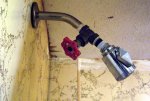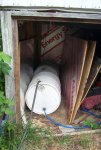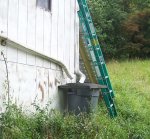You are using an out of date browser. It may not display this or other websites correctly.
You should upgrade or use an alternative browser.
You should upgrade or use an alternative browser.
11 gallons of water for a shower
- Thread starter Penn
- Start date
Welcome to the Precious Metals Bug Forums
Welcome to the PMBug forums - a watering hole for folks interested in gold, silver, precious metals, sound money, investing, market and economic news, central bank monetary policies, politics and more. You can visit the forum page to see the list of forum nodes (categories/rooms) for topics.
Why not register an account and join the discussions? When you register an account and log in, you may enjoy additional benefits including no ads, market data/charts, access to trade/barter with the community and much more. Registering an account is free - you have nothing to lose!
ancona
Praying Mantis
That's about right. I have had a complete and refreshing shower using a bag warmed five gallon sprinkle shower. It is nothing more than a bladder that is built in to the top of a fold up private shower that measures about 32" X 38". The water is warmed by the sun and dispensed through an overhead sprinkle system that looks lika a huge, old school shower head, but it is gravity feedc and controlled by a simple spring pull-back lever. I used it twice over a three day canoe trip and it was fine.
DCFusor
Yellow Jacket
I recently got my indoor plumbing running again. This time, it's two 55 gal plastic drums in the crawl space, which are fed in turn from my 50gal rain collector feed (all the water off my roof, quickly fills). Then a flojet pump, into qest-pex, two sinks, a tiny 120v electric hot water heater, and a very nice shower (Moen) - thermostatic controlled. I found I had to put a valve just behind the shower head, else it's a real hog. I'm doing anything between 10 and 20 gal a shower, depending. That valve behind the head lets me cut it down to "good" from "excessive" so I can stay in there awhile.
I have the water heater on a manual switch. Takes about 2 hours to heat a tank of about 8-10 gal (guessing). I don't run out of hot while showering, due to the thermostat control not using much hot till it cools down some.
Rain (off about 600sq ft) seems to be enough for me. If I had women here, it might be tight. I don't drink or cook off this - it's strictly toilet, dish and human washing.
But it's keeping up with me here in the not-rainy season just fine...and I no longer have to go fetch so much water. I fetch drinking water from various sources 55 gal at a time, and that seems to last me about 6 months - just tea and a little cooking.
Seems like a scheme I can live with. I'm going to replace that flojet with a "real" house pump/pressure tank (quieter), and then use the flojet to push water up from my spring (someday, it's a major job).
I have the water heater on a manual switch. Takes about 2 hours to heat a tank of about 8-10 gal (guessing). I don't run out of hot while showering, due to the thermostat control not using much hot till it cools down some.
Rain (off about 600sq ft) seems to be enough for me. If I had women here, it might be tight. I don't drink or cook off this - it's strictly toilet, dish and human washing.
But it's keeping up with me here in the not-rainy season just fine...and I no longer have to go fetch so much water. I fetch drinking water from various sources 55 gal at a time, and that seems to last me about 6 months - just tea and a little cooking.
Seems like a scheme I can live with. I'm going to replace that flojet with a "real" house pump/pressure tank (quieter), and then use the flojet to push water up from my spring (someday, it's a major job).
ancona
Praying Mantis
Hey DC,
Here in Florida, those who have wells and a separate, nopn-pressurized aeration tank [sulphur gas reduction] use a small tank [5 gal I think] which has a loosely filled blasser inside which as it fills, maintains pressure at 30 - 60 psi, as desired by the end user. You could put this in front of a tank being fed by a very small pump to maintain good pressure for only a few bucks. In addition, I have given away several 1/4" 316 stainless steel 50 +/- gallon ve4ssels to folks who want to use air as the mechanism for pressure and simply regulate it with a cheap compressor regulator and a blow off valve. Would that work for your purposes? In that event, the roof mounted tanks become obsolete.
Here in Florida, those who have wells and a separate, nopn-pressurized aeration tank [sulphur gas reduction] use a small tank [5 gal I think] which has a loosely filled blasser inside which as it fills, maintains pressure at 30 - 60 psi, as desired by the end user. You could put this in front of a tank being fed by a very small pump to maintain good pressure for only a few bucks. In addition, I have given away several 1/4" 316 stainless steel 50 +/- gallon ve4ssels to folks who want to use air as the mechanism for pressure and simply regulate it with a cheap compressor regulator and a blow off valve. Would that work for your purposes? In that event, the roof mounted tanks become obsolete.
DCFusor
Yellow Jacket
I don't have roof mount tanks, but yes, what I was talking about replacing the flojet (spot sprayer) pump with was your normal turbine pump and pressure tank like you describe. The flojet uses almost no electricity by comparison, but in the scheme of things, it's not really an issue - it was just quick and cheap to get going right away.
My shop (where I actually live) is uphill from the trailer I have plumbed. I collect all the rainwater off the shop roof into a big trashcan, with an overflow out and a screen in - I usually let that overflow so it loses anything floating on the water, and there's a silt sump below the pipe outlet. I then have a 50 foot pipe and valve that gravity feeds the cistern (110 gals of barrels) at the trailer in the crawl space over there. From that, it gets pumped into the plumbing. Very simple system, yet as effective as it gets.
Don't you guys get even more rain than we do? How is the resulting water quality? Here it's actually good to drink except for about 3 weeks in early spring or late fall - pollen. You might have jet exhaust in yours? That kind of thing isn't a problem here.
My shop (where I actually live) is uphill from the trailer I have plumbed. I collect all the rainwater off the shop roof into a big trashcan, with an overflow out and a screen in - I usually let that overflow so it loses anything floating on the water, and there's a silt sump below the pipe outlet. I then have a 50 foot pipe and valve that gravity feeds the cistern (110 gals of barrels) at the trailer in the crawl space over there. From that, it gets pumped into the plumbing. Very simple system, yet as effective as it gets.
Don't you guys get even more rain than we do? How is the resulting water quality? Here it's actually good to drink except for about 3 weeks in early spring or late fall - pollen. You might have jet exhaust in yours? That kind of thing isn't a problem here.
I also use this system.
I was given a sealed hot water tank that has a compressible airspace above a baffle.
The pump ( rated at 30 litres per minute )takes water from a passing stream. It cuts in at 1.75 bar and jacks pressure up to 2.5 bar by compressing the air space as it pushes water into the tank.
The electric shower is the most pressure critical device and occasionally refuses to heat the water until the pump has cut in and boosted pressure a bit.
All other taps work just like a mains supply and most visitors are unaware that they drink tadpole tea (-:
have also used upside down propane bottles, teed off a limited water supply with good pressure but bugger all flow, due to firring in the old pipes, to act as 'capacitors'.
I was given a sealed hot water tank that has a compressible airspace above a baffle.
The pump ( rated at 30 litres per minute )takes water from a passing stream. It cuts in at 1.75 bar and jacks pressure up to 2.5 bar by compressing the air space as it pushes water into the tank.
The electric shower is the most pressure critical device and occasionally refuses to heat the water until the pump has cut in and boosted pressure a bit.
All other taps work just like a mains supply and most visitors are unaware that they drink tadpole tea (-:
have also used upside down propane bottles, teed off a limited water supply with good pressure but bugger all flow, due to firring in the old pipes, to act as 'capacitors'.
Last edited:
ancona
Praying Mantis
DC,
Our rainwater is pretty clean, except when tehe storms are really windy and moving east to west. Then we get a lot of salt. It's not too much to drink, but you can really taste it, at least I can, but the Berkey seems to remove a lot of it if it's cool enough.
If you like, I will keep my eyes open during the rehabilitation of OPF-3, which we will be doing all demolition, for a nice, hopefully double wall vacuum jacketed, stainless steel takn. They're everywhere out at work, like cockroaches.
Our rainwater is pretty clean, except when tehe storms are really windy and moving east to west. Then we get a lot of salt. It's not too much to drink, but you can really taste it, at least I can, but the Berkey seems to remove a lot of it if it's cool enough.
If you like, I will keep my eyes open during the rehabilitation of OPF-3, which we will be doing all demolition, for a nice, hopefully double wall vacuum jacketed, stainless steel takn. They're everywhere out at work, like cockroaches.
bushi
Ground Beetle
- Messages
- 968
- Reaction score
- 7
- Points
- 143
Have you guys use low flow/aerators in your shower heads? That becomes pretty much a standard feature in new shower heads back at home (Poland). Basically it mixes outgoing water with air. Cuts on water use quite dramatically, versus traditional ones, while still giving you a very similar sensation of a reach, fat water stream.
quick find, what I am talking about
http://eartheasy.com/live_lowflow_aerators.htm
quick find, what I am talking about
http://eartheasy.com/live_lowflow_aerators.htm
ancona
Praying Mantis
Most lower end hotels have already adopted them here, and they are actually not that bad. By making the water more of an aerosol, you get a similar effect to adding a surfactant to water, you reduce it's surface tension. In Florida, our water is as hard as a rock, although I have become accustomed to it, and most folks in mid to upper range homes use softeners to reduce mineralization and to get themselves and their things cleaner. As far as the low-flow toilets, in some cases they simply won't work. When a septic field is covered in water from a five inch, two day rain, it is nearly impossible to flush the damn toilet sometimes because there is nowhere to go. You are literally displacing what is already there with more, forcing water in to a saturated drain field. This can and does get ugly at time. I will however, take my septic system any day over the high price sewerage our county offers.
DCFusor
Yellow Jacket
My Moen head has an aerator - and it's adjustable. Still, putting the valve in the line, since the thermostat control doesn't have a variable flow - is a good move. Since words didn't get it across, here's a snapshot of the system. The pump isn't shown, but it's just a spot sprayer pump with pressure switch, running off a trickle charged 12 battery, into a pressure tank, then the plumbing. That qest/pex tubing plumbing is the bomb!






DCFusor
Yellow Jacket
In this country, I don't bathe every day - not even every week. I bathe when I stink, and I don't sweat much most of the time.
BTW - key to making that thing sweet are the screen over the initial collection trashcan, the fact that the pipe coming off the bottom is really 3" off the bottom (silt sump) and an overflow hole near the top so floaters get washed out during a rain. This way, what gets into the real cistern is pretty clean. No floating tiny bugs, no silt.
BTW - key to making that thing sweet are the screen over the initial collection trashcan, the fact that the pipe coming off the bottom is really 3" off the bottom (silt sump) and an overflow hole near the top so floaters get washed out during a rain. This way, what gets into the real cistern is pretty clean. No floating tiny bugs, no silt.
